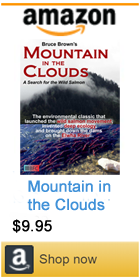‘Do Not Fear the (Coronavirus) Wolf’ by Bruce Brown
The wolf has come to make us strong and clean again!

IF I COULD say just one thing to you — this is what I’d say.
Do not fear the wolf, which has come to us now in the form of the coronavirus.
The wolf is actually a good thing for the human species, just as it is for the caribou and — as Farley Mowat’s Never Cry Wolf portrayed so memorably — the fat little arctic voles as well.
As with the arctic caribou and voles beyond counting, the predatory wolf will make us strong and clean again.
Here’s the matter of pandemics put simply. Every single pandemic that has ever afflicted the human species — from before the beginning of recorded history until now — has been been overcome and ended by simple behavioral and biological processes that are evident every day in the lives of human beings everywhere. This process produces what we call herd immunity.
And the vast majority of the time, our species has achieved herd immunity against epidemic disease after epidemic disease — without the benefit of an artifical, science-produced vaccine.
HERE IS A list of just a few of the epidemics that struck New York City in the 19th and 20th centuries, along with the number of people killed by the diseases. There were no vaccines available for any of these diseases at the time of the epidemics recorded:
- Yellow fever epidemic of 1805, 270 people died in New York
- Small pox epidemic of 1824, 394 people died in New York
- Cholera epidemic of 1834, 3,053 people died in New York
- Cholera epidemic of 1854, 5,071 people died in New York
- Diptheria epidemic of 1887, 4,509 people died in New York
- Meningitis epidemic of 1904, 2,219 people died in New York
- Spanish influenza epidemic of 1918, 12,562 people died in New York
So there were no vaccines for any of these killing diseases — what happened?
In each case, the disease flared and then burned through America’s largest city for as long and hard as herd immunity would let it, and then finally burned out as a super fire when the easy/weak victims had been killed, and selectively eliminated, and the immune portion of the population emerged.
There is considerable debate in the scientific community about how much of the population would have to be immune to COVID-19 to achieve herd immunity. In the past, something like 65 percent has been a commonly heard number, and COVID-19 antibody numbers like those have in fact already been observed in some hard hit New York City neighborhoods, according to the New York Times.
More recently, however, others have opined that herd immunity might actually be achieved with as little as 20 percent of the population immune to COVID-19. Gabriella Gomes, a professor at the University of Strathclyde, in Glasgow, Scotland, has been particularly outspoken in her belief that the herd immunity threshold is low, maybe even below 20 percent of the population.
“We just keep running the models, and it keeps coming back at less than 20 percent” to achieve herd immunity, Gomes said. “It’s very striking.”
AND PERHAPS the best news on the coronavirus news scene this summer are reports that after passing through hell in the spring, New York City may have achieved a measure of herd immunity to COVID-19 this summer.
The New York Times recently reported that hard-hit poor neighborhoods in New York were reporting coronavirus antibodies in more more than 60 percent of the population tested, which many scientists believe is more than sufficient to achieve herd immunity.
And CNN recently reported that the CDC under-estimated the number of people infected with COVID-19 this spring. In New York City, for instance, the CDC now thinks the infection rate was 12 times greater than reported at the time. Stated another way, that means that the CDC missed more than 90 percent of the coronavirus cases this spring.
In New York City, this would mean there were 642,000 people infected by COVID-19 by April 1, not the paltry 53,803 infections that were officially reported at the time, which is exceptionally good news on the herd immunity front.
SO HOW is this good news, you ask? Well, it’s fabulous, dance-in-the-streets good news because it means that many, many more people than originally thought have now been exposed to COVID-19, and thrown it off, many of them without even knowing they were sick!
Not only have these heroes of the pandemic demonstrated innate, inherited strength against the disease, it is hoped they now have some form of additional developed immunity against COVID-19 as well. We’re not sure exactly what yet, — but it will likely be expressed in the form of antibodies, T-cells, and possibly “immunological dark matter,” and it will convey SOME kind of increased immunity to COVID-19 going forward.
And this is EXACTLY what we’ve got to do to beat this pandemic — we’ve got to get enough people exposed so that the population as a whole can get to the to the herd immunity point where enough people are immune that the disease can’t flare to wildfire proportions. This is how humanity has beaten every plague that’s ever challenged it, and it’s how humanity will beat this plague too, with or without a vaccine.
A recent article in the Atlantic noted of New York:
Essentially, at present, New York City — which was hit very hard by the first coronavirus wave — might be said to be at a version of herd immunity, or at least safe equilibrium. Our case counts are very low. They have been low for weeks. Our antibody counts mean that a not-insignificant number of people are effectively removed from the chain of transmission.
Contrast that with the situation six months ago in New York and elsewhere in America, when there were many weakened individuals in extended care situations, and nursing homes full of the elderly, the injured and the brain dead. America was primed for a pandemic as 2020 dawned.
It was like a dry California forest in the summer with a lot of dry dead branches and assorting underbrush lying on the ground because forest management authorities stopped the natural burning process, and created super fires for their trouble — the forest fire equivalent of a pandemic.

THERE ARE two profound ironies and one badly mixed metaphor nested close together near the heart of the lotus of the coronavirus.
The first is a “hate to break it to ya” irony, namely that you can’t ride on the herd immunity bus unless you pay the fare, and the cost here is that many people must get infected with COVID-19 (the majority of whom will be asymptomatic and not even know they are sick) , and a few (about 1/2 of 1 percent of those infected) must die so the majority may live. Them’s the hard facts of the matter. We’re not dealing with a stroll in the park here; we’re dealing with a pandemic!
Now, if you’re a thoughtful reader who’s been paying attention to how the whole coronavirus thing has been playing out in terms of public policy in the Governor’s Amateur Hour now being enacted in every state in this great American nation, you may have noticed that what every governor in the United States is doing today is designed to SUPPRESS herd immunity, not achieve it.
Stated even more plainly — the face mask issue is a double edged sword just like everything else. It helps reduce person to person transmission, which is crucial for vulnerable portions of the population, but at the same time it is completely counter-productive for the vast majority of the population, who will only experience asymptomatic or very mild cases of COVID-19 if they become infected, and in the process probably achieve some additional immunity on top of their excellent native immunity, going forward, thereby increasing herd immunity.
So am I saying regulations requiring face masks are all wrong, and we should actually prohibit face masks?! No. I’m saying everyone who’s health is compromised should follow the full regulations as currently stipulated in the State of Washington. Everyone else should use good caution and prudence as their judgement as adult, tax-paying citizens of the State of Washington may dictate, and get on with it.
I recently compared COVID-19 to the big pandemics of the last century, and by my reckoning the one it compares to best in terms of kill rate, total deaths and general health/care impact is NOT the Spanish Influenza of 1918 (which is, of course, the biggest of them all), it’s the Asian flu of 1957-58.
The big difference between the two was that thanks to Dr. Maurice Hilleman, chief of respiratory diseases at the Walter Reed Army Institute of Research in Washington, D.C., America had a vaccine already developed and ready to go when the Asian flu hit the East Coast of the United States like a full force gale out of the South China Sea in the fall of 1957.
The vaccine helped speed the natural process to herd immunity against the Asian flu and saved many lives in the process, but in 1957 the process remained pretty much the way it always had been.
Nobody stopped the world because a deadly new virus had just blown in out of China. In 1957, people took the best precautions they could, and got on with their lives.
THE SECOND of the two profound ironies in the lotus of the coronavirus is that pandemics tend to make the surviving human species stronger — physically, emotionally and intellectually — because the weak have been selectively eliminated, and the strong have been tested.
A great leap forward for humanity sometimes follows within a century or two of the attack of a major plague, e.g. the European Age of Exploration following the Black Death; the European Age of Revolution following the Plague of 1665, the Age of High Tech following the Spanish Influenza, etc.
So we will hopefully be a stronger, more competitively capable species when this pandemic is over than we were when it started.
Do not fear the wolf. It is preparing us for greatness again.
— Bruce Brown
Editor, Coronavirus Vaccine & Herd Immunity Digest
1 thought on “‘Do Not Fear the (Coronavirus) Wolf’ by Bruce Brown”
Comments are closed.





Wow, this blogger is seriously impressive!